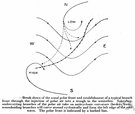polar front
Also found in: Thesaurus, Acronyms, Encyclopedia, Wikipedia.
Related to polar front: Polar high, Polar easterlies
polar front
n.
The region or boundary separating air masses of polar origin from those of tropical or subtropical origin.
American Heritage® Dictionary of the English Language, Fifth Edition. Copyright © 2016 by Houghton Mifflin Harcourt Publishing Company. Published by Houghton Mifflin Harcourt Publishing Company. All rights reserved.
polar front
n
(Physical Geography) meteorol a front dividing cold polar air from warmer temperate or tropical air
Collins English Dictionary – Complete and Unabridged, 12th Edition 2014 © HarperCollins Publishers 1991, 1994, 1998, 2000, 2003, 2006, 2007, 2009, 2011, 2014
po′lar front`
n.
the variable frontal zone of middle latitudes separating air masses of polar and tropical origin.
[1915–20]
Random House Kernerman Webster's College Dictionary, © 2010 K Dictionaries Ltd. Copyright 2005, 1997, 1991 by Random House, Inc. All rights reserved.
ThesaurusAntonymsRelated WordsSynonymsLegend:
Switch to new thesaurus
| Noun | 1. |  polar front - the front of an advancing mass of colder air polar front - the front of an advancing mass of colder airfront - (meteorology) the atmospheric phenomenon created at the boundary between two different air masses squall line - a cold front along which squalls or thunderstorms are likely |
Based on WordNet 3.0, Farlex clipart collection. © 2003-2012 Princeton University, Farlex Inc.